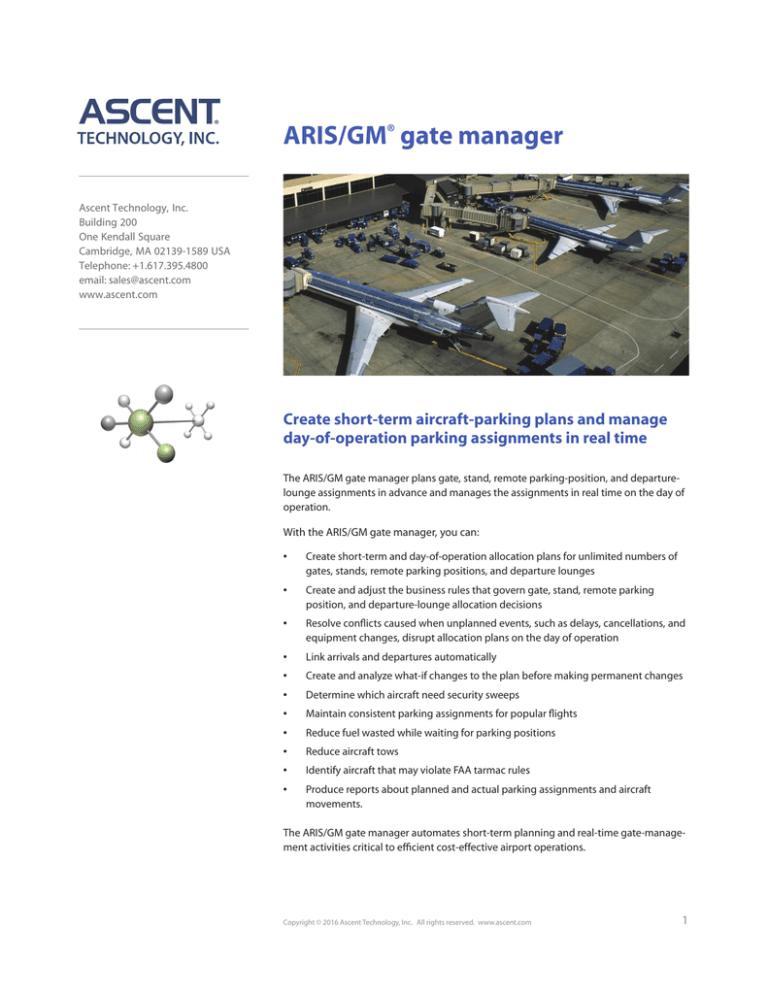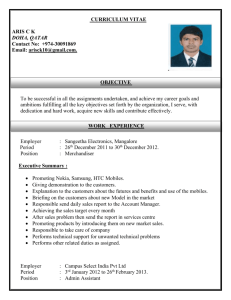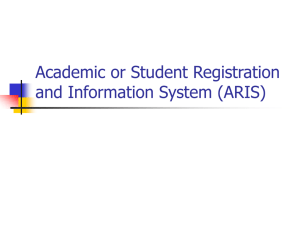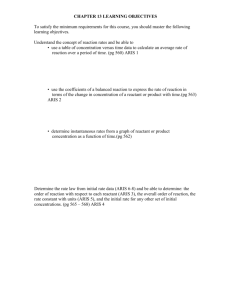
ARIS/GM® gate manager
Ascent Technology, Inc.
Building 200
One Kendall Square
Cambridge, MA 02139-1589 USA
Telephone: +1.617.395.4800
email: sales@ascent.com
www.ascent.com
Create short-term aircraft-parking plans and manage
day-of-operation parking assignments in real time
The ARIS/GM gate manager plans gate, stand, remote parking-position, and departurelounge assignments in advance and manages the assignments in real time on the day of
operation.
With the ARIS/GM gate manager, you can:
•
Create short-term and day-of-operation allocation plans for unlimited numbers of
gates, stands, remote parking positions, and departure lounges
•
Create and adjust the business rules that govern gate, stand, remote parking
position, and departure-lounge allocation decisions
•
Resolve conflicts caused when unplanned events, such as delays, cancellations, and
equipment changes, disrupt allocation plans on the day of operation
•
Link arrivals and departures automatically
•
Create and analyze what-if changes to the plan before making permanent changes
•
Determine which aircraft need security sweeps
•
Maintain consistent parking assignments for popular flights
•
Reduce fuel wasted while waiting for parking positions
•
Reduce aircraft tows
•
Identify aircraft that may violate FAA tarmac rules
•
Produce reports about planned and actual parking assignments and aircraft
movements.
The ARIS/GM gate manager automates short-term planning and real-time gate-management activities critical to efficient cost-effective airport operations.
Copyright © 2016 Ascent Technology, Inc. All rights reserved. www.ascent.com
1
Make decisions you can trust 100% of the time
The ARIS/GM gate manager delivers decisions you can trust. This means that the
ARIS/GM gate manager does more than merely notify you that a scheduling conflict
exists. A combination of extensive business knowledge and advanced decision-making
algorithms enables the ARIS/GM gate manager to resolve parking-position assignment
problems, even those that appear to have no obvious solution, quickly and efficiently.
Who we are
Since our founding 30 years ago
by members of the Massachusetts
Institute of Technology Artificial
Intelligence Laboratory, Ascent
Technology has helped organizations deploy costly resources as
efficiently, effectively, and economically as possible. Our highly trained
and capable team of technologists,
problem solvers, and solution
designers has broad domain ex-
The ARIS/GM gate manager takes into account hundreds of interrelated factors, such as
towing costs, passenger inconvenience, and disruption of parking-position assignments
for other flights. You control the rules that the ARIS/GM gate manager uses to make its
recommendations, and you can assign weights to them to establish their relative importance in determining a parking-position assignment strategy.
For example, you can set up hard rules that the ARIS/GM gate manager can never violate,
such as never parking two specific aircraft types at adjacent gates, and soft rules that
offer the ARIS/GM gate manager flexibility in making a gate-assignment decision. The
result is that you can always count on the ARIS/GM gate manager to deliver a workable
parking-position assignment solution. And, just as important, you can trust the ARIS/GM
gate manager to provide the best possible solution for a given situation.
The ARIS/GM gate manager is a flexible system that adapts to a wide range of operations
environments because it supports three levels of planning and analysis:
•
Medium-horizon planning of gate, stand, and parking-position allocations, when
aircraft-turn information becomes available
•
Short-horizon planning, when estimated arrival and departure times become
available
•
Real-time operations management, including responding to unplanned events.
pertise and substantial experience
in artificial intelligence, computer
science and engineering, system
design, mathematical optimization,
operations research, and resource
optimization, planning, scheduling,
and management.
Users at all levels of experience can work comfortably with the ARIS/GM gate manager
because it offers three distinct modes of operation, ranging from manual to fully automatic:
•
In manual mode, you make and change parking assignments yourself and use the
ARIS/GM gate manager to store and display the plans you create. When one of the
assignments or changes you want to make violates a constraint, the ARIS/GM gate
manager alerts you, so you can correct the error.
•
In semiautomatic mode, you share the planning process with the ARIS/GM gate
manager, relying on the system to make recommendations to resolve scheduling
conflicts and to evaluate the overall effectiveness of your plans.
•
In automatic mode, you rely on the ARIS/GM gate manager to create plans that
provide the best parking assignments and to provide real-time recommendations
for responding to irregular operations and unplanned events.
As scheduling requirements grow in size and complexity, the ARIS/GM gate manager’s
advanced problem-solving strategies, especially those involving real-time resolution
of parking assignment problems, clearly differentiate it from other gate-management
systems. The behavior of the ARIS/GM gate manager is determined by user-modifiable
rules that are stored with all relevant flight and airport facility information in the
ARIS/SmartBase® database. Because the rules are stored in a central knowledge base,
rather than in the ARIS/GM gate manager or in auxiliary files, you can change rules and
add or modify facility information without modifying the ARIS/GM gate manager itself.
Copyright © 2016 Ascent Technology, Inc. All rights reserved. www.ascent.com
2
Ascent airport architecture
Real-time changes to flights, such as updating estimated arrival times and changing
aircraft-registration information, can be made simply by pointing the mouse to the
relevant screen display area and entering new information. The ARIS/GM gate manager
automatically checks for conflicts and can be configured to accept a change only after
confirmation. The latter feature, known as the releasable information option, is an important safeguard because it prevents unverified changes from entering related systems,
such as FIDS, and potentially disrupting airport operations.
To build and sustain your trust in the solutions it recommends, the ARIS/GM gate manager
provides tools that enable you to understand the logic behind its decisions and to exercise
precise control over the subtleties in the rules and constraints that influence its recommendations. Business-knowledge inspection tools enable you to inspect the knowledge
base and to view the business rules in clear, English-language statements instead of arcane symbols and codes. At any time, users can ask the ARIS/GM gate manager to explain
its recommendation for a particular gate, stand, or parking assignment, and it will provide
a clear and concise description of the reasons behind the recommendation.
In typical daily operation, the ARIS/GM gate manager can be loaded with a pre-planned
gate and parking-position assignment schedule. Larger airports may find it efficient
to create this schedule using the ARIS/SP® stand planner. Based on the daily plan, the
ARIS/GM gate manager maintains consistent day-to-day assignments of gates, stands,
and parking positions insofar as possible. The ARIS/GM gate manager alerts you when it
must alter the plan because of flight delays, aircraft swaps, or other irregular operations.
In certain situations, such as when rapidly changing weather conditions are expected to
cause a major disruption of the daily plan, you can instruct the ARIS/GM gate manager to
re-plan the schedule for a selected group of flights from a specified time forward or to use
another set of rules automatically.
The ARIS/GM gate manager presents you with an intuitive, rapidly assimilated view of
the use of gates, stands, and parking positions; everything you need to know about the
current state of your operation is visible on a single display. The display provides scrollable
windows that enable you to move forward or backward in time and to view the status of a
virtually unlimited number of gates, stands, and parking positions. The main display area
uses a familiar Gantt chart to present the information, with colored lozenges representing the aircraft and a user-selectable palette of colors and symbols to indicate essential
information about each flight. You have the option of extending the Gantt chart across
multiple side-by-side monitors, in which case the ARIS/GM gate manager supports seamless mouse movement and information synchronization across all screens.
Copyright © 2016 Ascent Technology, Inc. All rights reserved. www.ascent.com
3
Representative features
Flight-time display keeps you fully informed. To help you assess how well the day’s
operations are progressing relative to the original plan, the ARIS/GM gate manager
displays all time-based information about flights. Using an innovative display technique, it
can show scheduled, estimated, and actual times for flights and tows without crowding the
display.
Display of next arrivals and next departures improves efficiency. You can focus your attention on the next activity without having to scroll through the GateChart to identify the next
event. Two panels contain flights sorted according to which one is most likely to depart next.
These panels contain indicators that show aircraft-parking and taxiing activities.
Automatic alerts warn of possible problems. The ARIS/GM gate manager automatically
issues warnings, shown in red on the GateChart, when it receives information, such as
changes in estimated times of arrival or departure that may create problems with scheduled allocations of parking positions. A user-configurable alert-management system warns
you about upcoming problems and enables you to acknowledge each alert individually.
Gate hierarchy simplifies parking large aircraft. The ARIS/GM gate manager can
combine two or more parking positions into larger ones to accommodate aircraft of any
size. Multiple levels of parking position combinations are supported, enabling airports to
handle larger aircraft as well as larger numbers of smaller aircraft.
Automatic aircraft swapping minimizes schedule disruptions. The ARIS/GM gate
manager handles arbitrary assignments of aircraft to flights. When carriers assign or
reassign aircraft, the time and cost effect on gate, stand, and parking-position allocations
can be substantial, especially when tows are required to swap aircraft. The ARIS/GM gate
manager re-links arrivals and departures, automatically determining the best solution to
minimize the effect of the reassignments in the processing, carefully balancing passenger
convenience with the cost of tows.
Departure lounges are allocated automatically. When buses are used to transport
passengers to and from flights, you can allocate both a parking position for the flight and
one or more waiting lounges. The ARIS/GM gate manager automatically integrates the
assignment of passenger-lounge areas and aircraft-parking positions. It identifies bus
gates with special graphical indicators on the GateChart and synchronizes them with flight
departure times.
Schedules are adjusted for inoperative equipment. The ARIS/GM gate manager tracks
problems related to inoperative airport facilities, such as malfunctioning jetways. You can
enter information about planned downtime for scheduled maintenance activities and
about unplanned downtime resulting from unexpected problems. The ARIS/GM gate manager uses special graphical indicators to alert you to these problems and also reminds you
when problems are scheduled to be resolved. The ARIS/GM gate manager automatically
factors these problems into its gate and parking-position allocation recommendations.
Graphic display based on the familiar Gantt chart. New users find it easy to make the transition from manual planning systems to the ARIS/GM gate manager because it uses a schedule
representation with which they are already familiar. This familiarity also reduces the amount of
training time required to become proficient in using the ARIS/GM gate manager.
Color indicators help clarify information display. The GateChart display uses color
coding to indicate a wide range of characteristics associated with flights and their gate-allocation status. You can select your own color preferences, and the ARIS/GM gate manager
remembers them.
Copyright © 2016 Ascent Technology, Inc. All rights reserved. www.ascent.com
4
Multi-user access. Changes made by one user are seen by all other users within a few
seconds. You can share responsibility for parts of the airport or you can split the work, for
example, by terminal.
Manual data entry gives you full control. Under normal conditions, flight information
used by the ARIS/GM gate manager is automatically captured from external systems, such
as flight-following systems and radar systems, using sophisticated connectivity software.
Should the information feed be interrupted for any reason, or if you need to make on-thefly updates, information about flight delays, new flights, returns, and cancellations can be
entered manually.
Zoom function makes GateChart easy to read. During periods of high activity, the
amount of information presented on the GateChart can make it difficult to view detailed
information about a particular flight. With the zoom function, you can magnify a
selected area of the GateChart display, while the ARIS/GM gate manager automatically
restructures the display to eliminate any information overlap that could cause confusion.
Search functions and group commands increase user efficiency. Rather than having
to scan the entire GateChart to find a specific flight, you can ask the ARIS/GM gate
manager to search for the flight that matches one or more of nearly four-dozen conditions. You can also perform express searches based on when, where, and why questions.
Group commands save time by enabling you to apply the same command to multiple
flights. For example, this makes it possible to use just one command to delay all flights
from a single origin by 10 minutes, rather than having to enter the same command
several times.
Smooth day-to-day transitions. The ARIS/GM gate manager supports flexible day
boundaries, which enables you to define an operating day with any starting and ending
times you prefer. This eliminates the need to switch calendar days to handle flights arriving after midnight.
Multiple-day plans handle overnight ground stays accurately. You can work with
allocation plans that span several days. This is particularly useful for airports that handle
overnight international flights or flights that cross international datelines. However,
because the ARIS/GM gate manager provides smooth scrolling from one day to another,
it is likely that several flights with the same flight number will appear on the GateChart.
To eliminate confusion, all flight information is identified by flight date.
Supports reporting and financial applications. All information processed by the
ARIS/GM gate manager is stored in the ARIS/SmartBase database, which runs on the
Oracle® database, where it is available for further processing and report generation by
Oracle-compatible products. Because the ARIS/GM gate manager logs all events for
all flights, it is an excellent source of accurate information for applications that invoice
airlines for airport services. It stores information about aircraft type, gates used, length of
time spent at a gate, tows, and services performed, among other things.
Intelligent data capture from multiple sources. The ARIS/SmartBase database
receives flight data via the ARIS/SmartBus® communication middleware, which ensures
consistent, reliable data capture from a wide range of data sources and external systems.
Built-in communications protocols enable the ARIS/SmartBase database to receive information from sources such as airline systems, airport systems, radar systems, and SITA.
Information processed by the ARIS/GM gate manager can drive systems, such as FIDS,
web servers, and information systems, that provide flight information to travelers, airport
and airline staff, handling agents, and other service providers and partners.
Copyright © 2016 Ascent Technology, Inc. All rights reserved. www.ascent.com
5
What-if analysis. When you load a particular current, future, or past day, the ARIS/GM
gate manager automatically assembles the business rules and airport configuration for
the day without any user involvement, such as changing the database account or loading a separate airport configuration file. This feature is particularly useful when airport
construction projects change the configuration of the physical assets frequently.
More information
To learn more about how Ascent
Technology solutions can help
you optimize your resources to
greatest advantage and to schedule
a demonstration of our products,
send email to sales@ascent.com or
call our Sales and Marketing
department at +1.617.395.4800.
Central database drives all decisions. The data and decision-making rules used by the
ARIS/GM gate manager are stored in the ARIS/SmartBase database. It contains easy-touse, fill-in-the-blanks panels, which make it possible for users to populate and modify the
database without programming. Data panels are used to capture flight information and
attributes of the airport that affect scheduling decisions. The knowledge panels provide
a convenient way to enter business rules and establish the weighting that controls how
the ARIS/GM gate manager applies them to its decision-making processes.
Airport scenario support. The ARIS/GM gate manager automatically selects the appropriate set of business rules to follow for the day loaded. You can change the way the airport
operates overnight, for example by adding new gates or changing the allocation rules, and
the ARIS/GM gate manager selects the correct business rules to follow.
Real-time updates to and from the database. The ARIS/GM gate manager automatically
synchronizes with the ARIS/SmartBase database before and after every command you
issue. If your workstation accidentally shuts down, you will not lose your work.
Reports
You can print hardcopies of the GateChart directly from the ARIS/GM gate manager. The
reports exploit the high resolution of today’s printers to provide many flight details in a
crisp graphical PostScript® format.
You can print detailed spreadsheet-like reports from the ARIS/GM gate manager that
contain important flight information, such as crew- and passenger-connection information when you also use the ARIS/CX® crew-connection analyzer and the ARIS/PX®
passenger-connection analyzer.
You can print the results of commands and search operations directly from the
ARIS/GM gate manager.
The ARIS/GM gate manager stores information in the ARIS/SmartBase database, which
runs on the Oracle® database. We can create reports for you, and you can create
your own reports from a synchronized reporting database using Oracle-compatible
report-generator tools, without interfering with the integrity or performance of the
ARIS/SmartBase database.
Ways we can help you
Advisory and consulting services. We provide unbiased advice about resource allocation, optimization, planning, scheduling, management, and deployment methodologies;
develop cost-benefit analyses; analyze business processes; manage projects; gather
and document technical requirements; develop functional specifications; and specify
hardware, software, and devices.
Copyright © 2016 Ascent Technology, Inc. All rights reserved. www.ascent.com
6
Project management services. Our project management team works closely with you,
following our time-proven delivery methodology, and uses face-to-face meetings, teleconferences, web conferences, and email exchanges to keep you informed every step
of the way. We believe careful project management is the key to successful on-time and
on-budget deliveries of SmartAirline Operations Center and SmartAirport Operations
Center products, services, and solutions.
Knowledge engineering services. Knowledge engineering is the process of identifying your business knowledge—the business rules, policies, procedures, preferences,
and requirements that guide the way your organization operates—and then codifying
your business knowledge in the knowledge base at the heart of SmartAirline Operations Center and SmartAirport Operations Center solutions. The business knowledge in
the knowledge base determines how the solutions behave. Our knowledge engineers
work with you to gather and enter the business knowledge that enables the solution to
behave exactly the way you want it to.
ARIS, ARIS/AR, ARIS/AV, ARIS/BB, ARIS/CI, ARIS/CX, ARIS/FW,
ARIS/GateView, ARIS/GM, ARIS/IQ, ARIS/LegGen, ARIS/PX,
ARIS/SA, ARIS/SB, ARIS/SE, ARIS/SmartBase, ARIS/SmartBus,
ARIS/SP, ARIS/Tow Panel, ARIS/WorkModel, ARIS/WorkNet,
ARIS/WorkOptimize, ARIS/WorkPlan, ARIS/WorkRelay,
ARIS/WorkTime, Ascent Technology, Inc. (stylized), Ascent
WorkZone, Ascent WorkZone (stylized), GateKeeper, Right
Now View, SmartAirline, SmartAirline Capacity Analyzer
(stylized), SmartAirline Operations Manager (stylized),
SmartAirline WorkZone, SmartAirline WorkZone (stylized),
SmartAirport, Smartairport.com, SmartAirport Capacity
Analyzer, SmartAirport Capacity Analyzer(stylized),
SmartAirport Information Manager, SmartAirport
Information Manager(stylized), SmartAirport Operations,
SmartAirport Operations Center, SmartAirportOperations
Manager, SmartAirport Operations Manager (stylized),
SmartAirport WorkZone, and SmartAirport WorkZone
(stylized) are registered trademarks of Ascent
Technology,Inc., in the United States.
Active Schedules, Advanced Pay Rule System, ARIS/AR
Display Board, ARIS/AR Turn Generator, ARIS/BIS, ARIS/CA,
ARIS/Reports, ARIS/SCR, ARIS/SL, ARIS/SmartView, Ascent
WebConnect, Location Editor, Planning Control, Planning
Schedules, Profile Editor, Reference Editor, Resource Editors,
Rule Editor, SmartAirline Capacity Analyzer, SmartAirline
Operations Center, SmartAirline Operations Manager,
Template Worker Editor, User Editor, Work Schedule Editor,
Work Schedule Manager, and Worker Editor are trademarks
of Ascent Technology, Inc., in the United States.
This is not a complete list of all registered trademarks,
trademarks, and service marks owned by Ascent
Technology, Inc. Other company, product, and service
names may be registered trademarks, trademarks, or
service marks owned by other parties.
Copyright © 2016 Ascent Technology, Inc. All rights
reserved. www.ascent.com. Revised 10/2016
Implementation, integration, and installation services. Our implementation team
provides system integration and testing services; develops product extensions, enhancements, and connectivity software for importing data to and exporting data from external
systems; and creates reports. The team also configures, installs, and tests hardware,
software, and equipment for you when you choose to integrate the SmartAirline Operations Center or the SmartAirport Operations Center solutions in your IT environment, and
quickly sets up an environment in our hosting center for you when you choose to gain
access to the solutions over the web.
Training services. We provide a wide range of user, administrator, trainer, and refresher
training classes in person at your location, at our Cambridge, MA, headquarters, and
remotely over the web. We also provide operational training services in person and
remotely when you begin to use the SmartAirline Operations Center or SmartAirport
Operations Center solutions in production.
Maintenance and support services. We offer Standard Support Services Monday
through Friday during our normal office hours in Cambridge, MA, and Premium Support
Services around the clock. Both provide comprehensive remote user support services via
telephone, email, and Internet, as well as software maintenance, such as product updates,
patches, and releases. We provide a web-enabled support portal that enables you to ask
questions and receive responses, request service, report problems, and track issues.
Technology platform
You can gain access to the SmartAirline Operations Center or SmartAirport Operations Center solutions in two ways: you can integrate the solution into your own IT
environment, or you can gain access over the Internet to the solution running in our IT
environment in our hosting center.
Database server: A server that supports Oracle® 11g or 12c Database Server Standard
Edition
Compute and/or connectivity server: A server running Microsoft® Windows® Server™
2012 operating system or Red Hat® Enterprise Linux 7; if virtualized, our solutions are
certified to run on VMware® server virtualization products
Desktop: A PC running Microsoft Windows 7, 8, or 10 operating system
Copyright © 2016 Ascent Technology, Inc. All rights reserved. www.ascent.com
7









